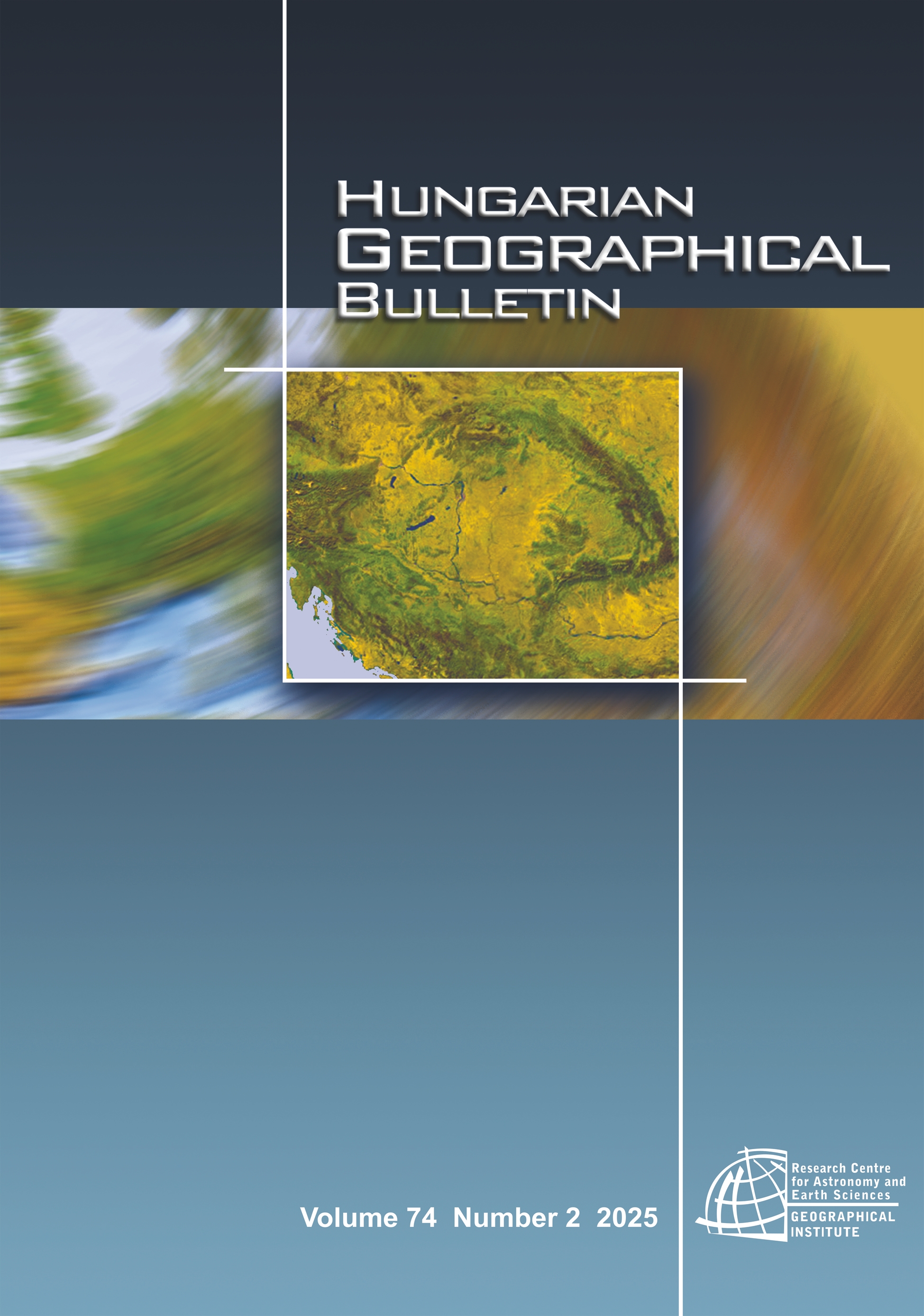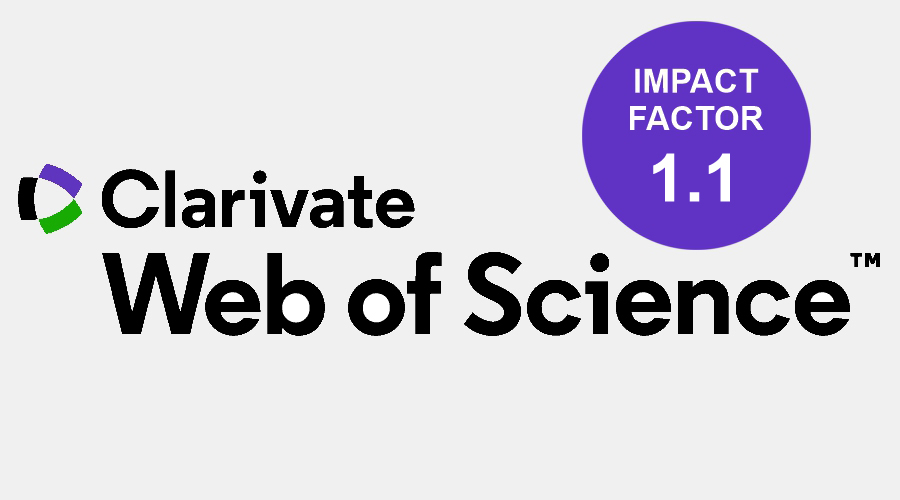The risk of urban floods caused by precipitation on the example of Bydgoszcz, Poland
Abstract
The article concerns the flood risk assessment in Bydgoszcz in April–October 2010–2022. The distribution of daily precipitation sums for two meteorological stations in Bydgoszcz was analysed. The study confirmed that the risk of extreme precipitation is greatest in the summer months (May–August). It was found that some of the intense rainfall that might cause short-term flooding of urban areas was often local and caused by storm phenomena. Analysis of flood-related interventions by the State Fire Service in Bydgoszcz showed that 2022 had the highest number of incidents (117). The analysis of precipitation and State Fire Service interventions showed a small degree of dependence between the two, both at the city-wide scale and for individual city districts. The spatial distribution of these interventions allowed the Bydgoszcz city districts most exposed to the effects of pluvial flooding to be identified. The work showed the complexity of the issue of urban flood risk, of monitoring such phenomena at the city and district scales, and of countering the effects of such phenomena.
References
Act, 2007. Act of April 26, 2007. Crisis Management. Official Gazette 2007, item 590 (in Polish).
AJJUR, S.B. and AL-GHAMDI, S.G. 2022. Exploring urban growth–climate change–flood risk nexus in fast growing cities. Scientific Reports 12. 12265. https://doi.org/10.1038/s41598-022-16475-x
ALFIERI, L., BUREK P., FEYEN, L. and FORZERI, G. 2015. Global warming increases the frequency of river floods in Europe. Hydrology and Earth System Sciences 19. 2247–2260. https://doi.org/10.5194/hess-19-2247-2015
ASADIEH, B. and KRAKAUER, N.Y. 2015. Global trends in extreme precipitation: Climate models versus observations. Hydrology and Earth System Sciences 19. 877–891. https://doi.org/10.5194/hess-19-877-2015
BĄK, B. and ŁABĘDZKI, L. 2013. Przestrzenne zróżnicowanie suszy meteorologicznej i rolniczej w rejonie bydgosko–toruńskim (Spatial variability of meteorological and agricultural drought in Bydgoszcz–Toruń Region). Acta Scientiarum Polonorum, Formatio Circumiectus 12. (2): 3–12.
CEC, 2009. Adapting to climate change: Towards a European framework for action. Brussels, Commission of the European Communities (CEC). https://eur-lex.europa.eu/LexUriServ/LexUriServ.do?uri=SEC:2009:0417:FIN:EN:PDF
CHO, S.Y. and CHANG, H.J. 2017. Recent research approaches to urban flood vulnerability, 2006–2016. Natural Hazards 88. 633−649. https://doi.org/10.1007/s11069-017-2869-4
CHORYŃSKI, A., PIŃSKWAR, I., GRACZYK, D. and KRZYŻANIAK, M. 2022. The emergence of different local resilience arrangements regarding extreme weather events in small municipalities – A case study from the Wielkopolska Region, Poland. Sustainability 14. 2052. https://doi.org/10.3390/su14042052
EEA, 2023. Economic losses from weather- and climate-related extremes in Europe. Copenhagen, Denmark, European Environmental Agency. https://www.eea.europa.eu/en/analysis/indicators/economic-losses-from-climate-related
EEA, 2024. Urban adaptation in Europe: what works? Implementing climate action in European cities. European Environmental Agency Report 14/2023. Copenhagen, Denmark, European Environmental Agency. https://www.eea.europa.eu/en/analysis/publications/urban-adaptation-in-europe-what-works
FALCONER, R.H., COBBY, D., SMYTH, P., ASTLE, G., DENT, J. and GOLDING, B. 2009. Pluvial flooding: New approaches in flood warning, mapping and risk management. Journal of Flood Risk Management 2.198–208. https://doi.org/10.1111/j.1753-318X.2009.01034.x
GRACZYK, D., KUNDZEWICZ, Z.W., CHORYŃSKI, A., FØRLAND, E.J., PIŃSKWAR, I. and SZWED, M. 2019. Heat-related mortality during hot summers in Polish cities. Theoretical and Applied Climatology 136. 1259–1273. https://doi.org/10.1007/s00704-018-2554-x
GRZYWNA, A., BOCHNIAK, A., ZIERNICKA-WOJTASZEK, A., KRUŻEL, J., JÓŹWIAKOWSKI, K., WAŁĘGA, A., CUPAK, A., MAZUR, A., OBROŚLAK, R. and SERAFIN, A. 2020. The analysis of spatial variability of precipitation in Poland in the multi-years 1981–2010. Journal of Water and Land Development 46. 105–111. https://doi.org/10.24425/jwld.2020.134202
GUO, K., GUAN, M. and YU, D. 2021. Urban surface water flood modelling – a comprehensive review of current models and future challenges. Hydrology and Earth System Sciences 25. 2843–2860. https://doi.org/10.5194/hess-25-2843-2021
HALECKI, W. and MŁYŃSKI D. 2025. Urban flood dilemmas: How European cities’ growth shapes flood risk and resilience strategies? Journal of Environmental Management 374. 124161. https://doi.org/10.1016/j.jenvman.2025.124161
HUANG, Y., TIAN, Z., KE, Q., LIU, J., IRANNEZHAD, M., FAN, D., HOU, M. and SUN, L. 2020. Nature-based solutions for urban pluvial flood risk management. WIREs Water 7. (3): 1–17. https://doi.org/10.1002/wat2.1421
IPCC, 2014. Climate Change 2014: Synthesis Report. Contribution of Working Groups I, II and III to the Fifth Assessment Report of the Intergovernmental Panel on Climate Change. Eds.: Core Writing Team, PACHAURI, R.K. and MEYER, L.A.; Geneva, CH, Gian-Kasper Plattner, IPCC.
KALBARCZYK, R. and KALBARCZYK, E. 2024. Risk of natural hazards caused by extreme precipitation in Poland in 1951–2020. Water 16. 1705. https://doi.org/10.3390/w16121705
KAMENSKÁ, M. and SMATANOVÁ, K. 2022. The impacts of climate change on urban structures in Slovak cities: Identifying vulnerable urban structures. Architecture Papers of the Faculty of Architecture and Design STU 1/22. (27): 33–39. https://doi.org/10.2478/alfa-2022-0005
KASZEWSKI, B.M. and FLIS, E. 2014. Meteorologiczne i klimatologiczne zdarzeni ekstremalne w polskiej literaturze (Extreme weather and climate phenomena in Polish publications). Prace Geograficzne 139. 7–20. https://doi.org/10.4467/20833113PG.14.021.3011
KOCSIS, T., PONGRÁCZ, R., HATVANI, I.G., MAGYAR, N., ANDA, A. and KOVÁCS-SZÉKELY, I. 2024. Seasonal trends in the Early Twentieth Century Warming (ETCW) in a centennial instrumental temperature record from Central Europe. Hungarian Geographical Bulletin 73. (1): 3–16. https://doi.org/10.15201/hungeobull.73.1.1
KRON, W., LÖW, P. and KUNDZEWICZ, Z.W. 2019. Changes in risk of extreme weather events in Europe. Environmental Science and Policy 100. 74–83. https://doi.org/10.1016/j.envsci.2019.06.007
KUBAL, C., HAASE, D., MEYER, V. and SCHEUER, S. 2009. Integrated urban flood risk assessment – adapting a multi-criteria approach to a city. Natural Hazards and Earth System Sciences 9. 1881–1895. https://doi.org/10.5194/nhess-9-1881-2009
KUBIAK-WÓJCICKA, K. 2020. Variability of air temperature, precipitation and outflows in the Vistula basin (Poland). Resources 9. 1–26. https://doi.org/10.3390/resources9090103
KUBIAK-WÓJCICKA, K., PILARSKA, A. and KAMIŃSKI, D. 2021. The analysis of long-term trends in the meteorological and hydrological drought occurrences using non-parametric methods – Case study of the catchment of the upper Noteć river (Central Poland). Atmosphere 12. 1098. https://doi.org/10.3390/atmos12091098
KUBIAK-WÓJCICKA, K., PILARSKA, A. and KAMIŃSKI, D. 2024. Meteorological drought in the upper Noteć catchment area (Central Poland) in the light of NDVI and SPI indicators. Applied Water Sciences 14. 180. https://doi.org/10.1007/s13201-024-02215-1
KUMAR, S.V. and SINGH, G.S. 2022. A systematic approach for effective storm water management at building level during extreme rainfall events – A case study. Urban Water Journal 20. (10): 1–11. https://doi.org/10.1080/1573062X.2021.2020301
KUNDZEWICZ, Z.W. 2011. Zmiany klimatu, ich przyczyny i skutki – Obserwacje i projekcje (Climate changes, their reasons and effects – Observations and projections). Landform Analysis 15. 39–49.
KUŚMIEREK-TOMASZEWSKA, R. and ŻARSKI, J. 2021. Assessment of meteorological and agricultural drought occurrence in Central Poland in 1961–2020 as an element of the climatic risk to crop production. Agriculture 11. 855. https://doi.org/10.3390/agriculture11090855
ŁASZYCA, E. 2018. Ocena zasobów i zagrożeń meteorologicznych w rejonie Bydgoszczy w latach 1971–2010. (Assessment of meteorological resources and threats in the Bydgoszcz region in the years 1971–2010). Doctoral dissertation. Bydgoszcz, UTP.
ŁUPIKASZA, E.B. 2017. Seasonal patterns and consistency of extreme precipitation trends in Europe, December. 1950. to February. 2008. Climate Research 72. (3): 217–37. https://doi.org/10.3354/cr01467
MAIER, R., KREBS, G., PICHLER, M., MUSCHALLA, D. and GRUBER, G. 2020. Spatial rainfall variability in urban environments-high-density precipitation measurements on a city-scale. Water 12. 1157. https://doi.org/10.3390/w12041157
MAROSZ, M., MIĘTUS, M. and BIERNACIK, D. 2023. Features of multiannual air temperature variability in Poland (1951–2021). Atmosphere 14. 282. https://doi.org/10.3390/atmos14020282
MIKOŁAJEWSKI, K., STACH, A., RUMAN, M., KOSEK, K., KUNDZEWICZ, Z.W. and LICZNAR, P. 2025. Heavy rainfalls in Poland and their hyetographs. Ambio 54. 86–104. https://doi.org/10.1007/s13280-024-02069-6
PERERA, A.C.S., DAVIES, P. and GRAHAM, P. 2024. A global review of urban blue-green planning tools. Land Use Policy 140. 107093. https://doi.org/10.1016/j.landusepol.2024.107093
PIASECKI, K. and ŻMUDZKA, E. 2022. Severe storms as an example of a natural hazard in the urban area – Case studies of the area of Warsaw, Poland. Miscellanea Geographica – Regional Studies on Development 26. (1): 63–74. https://doi.org/10.2478/mgrsd-2020-0065
PIŃSKWAR, I., CHORYŃSKI, A., GRACZYK, D. and KUNDZEWICZ, Z.W. 2019. Observed changes in extreme precipitation in Poland: 1991–2015 versus 1961–1990. Theoretical and Applied Climatology 135. 773–787. https://doi.org/10.1007/s00704-018-2372-1
PIŃSKWAR, I. 2022. Complex changes of extreme precipitation in the warming climate of Poland. International Journal of Climatology 42. (2): 817–833. https://doi.org/10.1002/joc.7274
PIŃSKWAR, I., CHORYŃSKI, A. and GRACZYK, D. 2023. Risk of flash floods in urban and rural municipalities triggered by intense precipitation in Wielkopolska of Poland. International Journal of Disaster Risk Science 14. 440–457. https://doi.org/10.1007/s13753-023-00493-y
PRADHAN, P., SEYDEWITZ, T., ZHOU, B., LÜDEKE, M.K. and KROPP, J.P. 2022. Climate extremes are becoming more frequent, co-occurring, and persistent in Europe. Anthropocene Science 1. (8): 264–277. https://doi.org/10.1007/s44177-022-00022-4
PROKIĆ, M., SAVIC, S. and PAVIC, D. 2019. Pluvial flooding in urban areas across the European continent. Geographica Pannonica 23. (4): 216–232. https://doi.org/10.5937/gp23-23508
RADU, C., BETERINGHE, A. and RĂDUC, M.A. 2021. Vulnerability of urban floods in association with the sewage system and geographical features in the Giulești – Sârbi neighborhood, Bucharest, Romania. Present Environment and Sustainable Development 15. 2. 221–234. https://doi.org/10.15551/pesd2021152018
Raport, 2023. Raport o stanie miasta Bydgoszczy za 2022 rok (Report on the state of the city of Bydgoszcz for 2022). Bydgoszcz, Prezydent miasta Bydgoszczy. https://www.bydgoszcz.pl/fileadmin/multimedia/rozwoj/Dokumenty/SPRAWOZDANIA_Z_REALIZACJI/Raport_2022.pdf
ROBINSON, A., LEHMANN, J., BARRIOPEDRO, D., RAHMSTORF, S. and COUMOU, D. 2021. Increasing heat and rainfall extremes now far outside the historical climate. npj Climate and Atmospheric Science 4. 45. https://doi.org/10.1038/s41612-021-00202-w
SHORT, J.R. and FARMER, A. 2021. Cities and climate change. Earth 2. 1038–1045. https://doi.org/10.3390/earth2040061
SIWIEC, E. (ed.) 2022. Atlas skutków zjawisk ekstremalnych w Polsce. Klimada 2.0. (Atlas of the effects of extreme phenomena in Poland. Climate 2.0.). Warszawa, Instytut Ochrony Środowiska – Państwowy Instytut Badawczy.
SKOUGAARD KASPERSEN, P., HØEGH RAVN, N., ARNBJERG-NIELSEN, K., MADSEN, H. and DREWS, M. 2017. Comparison of the impacts of urban development and climate change on exposing European cities to pluvial flooding. Hydrology and Earth System Sciences 21. (8): 4131–4147. https://doi.org/10.5194/hess-21-4131-2017
Statistics Poland, 2022. Local Data Bank. https://bdl.stat.gov.pl/bdl/start. Accessed 15.02.2024
SULIK, S. and KEJNA, M. 2022. Spatial diversity of cloud-to-ground lightning flashes in the Kujawsko-Pomorskie voivodeship (Poland), 2002–2019. Geographia Polonica 95. (1): 5–23. https://doi.org/10.7163/GPol.0224
SUN, X., LI, R., SHAN, X., XU, H. and WANG, J. 2021. Assessment of climate change impacts and urban flood management schemes in central Shanghai. International Journal of Disaster Risk Reduction 65. 102563. https://doi.org/10.1016/j.ijdrr.2021.102563
TABARI, H. 2020. Climate change impact on flood and extreme precipitation increases with water availability. Scientific Reports 10. 13768. https://doi.org/10.1038/s41598-020-70816-2
ULLAH, I., KOVÁCS, G. and LENNER, T. 2023. Urban flood resilience assessment using Arc GIS based AHP approach: A case study of Gyor city, Hungary. EGU General Assembly 2023, Vienna, Austria, 24–28 Apr 2023, EGU23-15092, https://doi.org/10.5194/egusphere-egu23-15092
WEBBER, J.L., GIBSON, M.J., CHEN, A.S., SAVIC, D., FU, G. and BUTLER, D. 2018. Rapid assessment of surface-water flood-management options in urban catchments. Urban Water Journal 15. (3): 210–217. https://doi.org/10.1080/1573062X.2018.1424212
ZHOU, Q., LENG, G. and HUNAG, M. 2018. Impacts of future climate change on urban flood volumes in Hohhot in northern China: Benefits of climate change mitigation and adaptations. Hydrology and Earth System Sciences 22. (1): 305–316. https://doi.org/10.5194/hess-22-305-2018
ZIERNICKA-WOJTASZEK, A. and KOPCIŃSKA, J. 2020. Variation in atmospheric precipitation in Poland in the years 2001–2018. Atmosphere 11. (8): 794. https://doi.org/10.3390/atmos11080794
Copyright (c) 2025 Katarzyna Kubiak-Wójcicka, Bogdan Bąk, Mohamed-Sadek Messis

This work is licensed under a Creative Commons Attribution-NonCommercial-NoDerivatives 4.0 International License.






